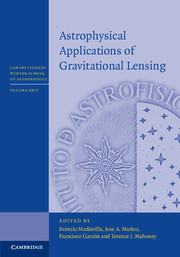
-
Select format
-
- Publisher:
- Cambridge University Press
- Publication date:
- September 2016
- October 2016
- ISBN:
- 9781139940306
- 9781107078543
- Dimensions:
- (247 x 174 mm)
- Weight & Pages:
- 0.75kg, 302 Pages
- Dimensions:
- Weight & Pages:
You may already have access via personal or institutional login
Book description
Gravitational lenses offer the best, and sometimes the only, means of tackling key problems in many fields of astrophysics and cosmology. According to Einstein's theory, the curvature of light-rays increases with mass; gravitational lenses can be used to map the distribution of mass in a Universe in which virtually all matter is dark matter of an unknown nature. Gravitational lensing has significantly improved our knowledge of many astrophysical phenomena, such as exoplanets, galaxies, active galactic nuclei, quasars, clusters, large-scale structure and the Universe itself. All these topics are covered fully in this book, together with two tutorials on lens and microlensing modelling. The future of lensing in relation to large surveys and the anticipated discoveries of thousands more gravitational lenses is also discussed, making this volume an ideal guide for postgraduate students and practising researchers in the use of gravitational lenses as a tool in their investigations.
Reviews
'Each article is self-contained and as a whole it presents an overview of the field of strong lensing … For the reader who is entering the filed this is a useful collection that summarizes it well.'
Alan Heavens Source: The Observatory
Contents
Metrics
Altmetric attention score
Full text views
Full text views help Loading metrics...
Loading metrics...
* Views captured on Cambridge Core between #date#. This data will be updated every 24 hours.
Usage data cannot currently be displayed.
Accessibility standard: Unknown
Why this information is here
This section outlines the accessibility features of this content - including support for screen readers, full keyboard navigation and high-contrast display options. This may not be relevant for you.
Accessibility Information
Accessibility compliance for the PDF of this book is currently unknown and may be updated in the future.


